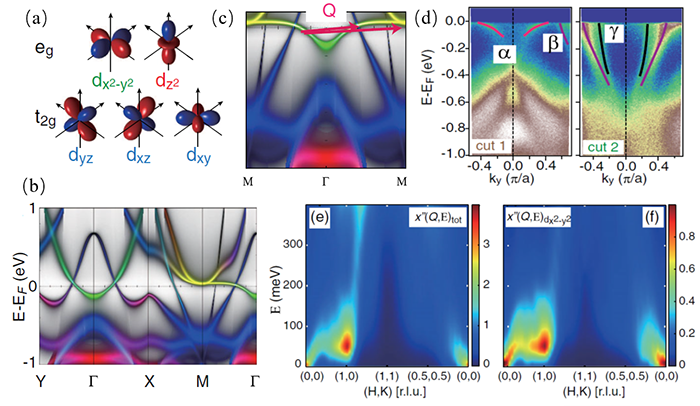Recent Achievement on Spin Fluctuation and Electronic Flatband in Iron-Based Superconductors and Related Materials
Date:11-04-2019 | 【Print】 【close】
Collaboration with Prof. Zhiping Yin in Beijing Normal University and Prof. Dawei Shen and Zhonghao Liu’s group in SIMIT, Prof. Pengcheng Dai and Yu Li in Rice University have a significant achievement on the study of spin fluctuation and electronic flatband in SrCo2As2, by using neutron scattering, angle-resolved photoemission spectroscopy experimental measurements and dynamic mean field theory calculation. They first experimental confirm that both antiferromagnetic (AFM) and ferromagnetic (FM) spin fluctuations in SrCo2As2 are closely associated with a flatband of the dx2-y2 orbital near the Fermi level, different from the t2g orbitals in superconducting SrFe2-xCoxAs2. The paper tilted with ‘Coexistence of Ferromagnetic and Stripe Antiferromagnetic Spin Fluctuations in SrCo2As2’ has been published on Physical Review Letters 122, 117204 (2019).
In iron-based superconductors such as AFe2-xCoxAs2 (A=Ca, Sr, Ba), the dominant interactions are AFM order and superconductivity, which has singlet electron pairing, arises by doping an electron with cobalt substitution to suppress static AFM order. While AFM spin fluctuations and superconductivity in iron pnictides are believed to arise from the nesting of the Fermi surfaces, which are mainly derived from t2g orbitals. Along with the increased filling of the electronic 3d shell and the decreased strength of electronic correlations, the chemical potential shifts up. dx2-y2 orbital near the Fermi level forming the flatband is beginning to dominate the electronic properties of the materials.
In this work, the longitudinally elongated AFM spin fluctuations and in-plan FM spin fluctuations have been observed by neutron scattering. From ARPES measurements and the DFT+DMFT calculations, they found a flatband consisting of the dx2-y2 orbital along the G-M direction right above the Fermi level, leading to a prominent peak in the density-of-state responsible for both the FM and AFM spin fluctuations. The observation is consistent with the proposal that FM fluctuations are detrimental to superconductivity in Co-overdoped AFe2-xCoxAs2. The findings are very important for study the electronic correlation effects, the multiple orbital physics and the electron-pairing mechanism in iron-based superconductors.
Paper link:
https://journals.aps.org/prl/abstract/10.1103/PhysRevLett.122.117204
